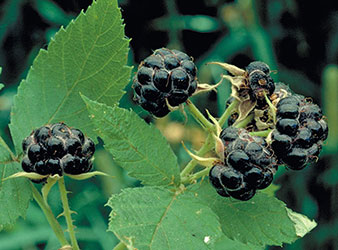On most trips into a beautiful woodland these two fruits are usually hanging out. Sometimes a sweet treat and other a not so welcome run in. On that note, What do Raspberries and Gooseberry have in common?

You can validate your puzzle solution with certitude.
Red Raspberries
Although there are numerous species in the Rubus genus that bear some resemblances to red raspberries (including thimbleberries, dwarf raspberries, black raspberries, and numerous dewberry species), there is only one “true” wild red raspberry: Rubus idaeus. It is native to the United States and is found throughout most of Minnesota with the possible exception of the southwestern corner and a few scattered counties elsewhere.
It’s no surprise that wild red raspberries resemble the supermarket variety—commercial crops are derived from R. idaeus. Other than their smaller size, fruits picked in the wild look exactly like their domestic cousins, making identification easy.
Red raspberries thrive in areas with full to partial sun, including open woodlands, forest edges, roadsides, streambanks, ravines, and untamed prairies and grasslands. They often appear a year or two after an area has been cleared, whether intentionally or due to fires, and they are not particular about soil, growing in sandy soil, swampy areas, and almost everything in between.
Stems—called canes—are up to 5 feet long and may be upright or arching; they are distinctly bristly but have no thorns. Leaves are compound, with three to five egg-shaped to oblong leaflets on each leaf stalk; the leaf stalks are arranged alternately on the canes. The top sides of the leaves are rich green, while undersides are silvery and hairy; edges have coarse teeth and the leaf tips are pointed. Red raspberries often grow in colonies.
Raspberries are biennial. First-year canes have leaves with five leaflets and do not produce flowers. In the second year, leaves have three leaflets; the plants produce white flowers that develop into the familiar fruit. Look for ripe red raspberries from midsummer through late summer. Ripe fruits detach easily from the plant, leaving the core behind so the picked fruit is hollow. Wild red raspberries can be eaten raw or used in any recipe as a substitute for store-bought red raspberries.
The Other Red Raspberry

If you find plants that resemble red raspberries but have thorns and a whitish bloom on the canes, you have probably found black raspberries (Rubus occidentalis). Underripe black raspberries pass through a red stage that looks similar to red raspberries, but the fruits are hard and don't detach easily from the core. Black raspberries are delicious; note the location of underripe fruit and return in a week or so to harvest ripe fruits, which are blackish-purple and hollow when picked. In Minnesota, this species is most common in the southern half of the state.
Currant or Gooseberry
Five varieties of currants (Ribes spp.) are native to Minnesota and are easy to confuse with gooseberries because their leaves are quite similar. Two key points make it easy to separate the two. First, currant shrubs have no prickles or bristles on the stems, while gooseberry stems have scattered to dense bristles. Second, currant fruits grow in hanging clusters, with six to 20 (or more) fruits on each fruiting stem. Ripe fruits range from red to reddish-purple to black; most are slightly smaller than gooseberries, but have the same pigtail on the end. Currants are edible, so misidentification wouldn't be tragic.
Fast Facts
Bees are the primary pollinators for blueberries, though nocturnal moths might also pollinate the plants.
In the past, the appearance of serviceberry blooms in the woods signaled that the ground was soft enough to dig graves—and hold services—for those who had passed in the winter.
The ancient Greeks harvested raspberries as early as 370 BCE.
Old legends say that fairies hide under the gooseberry's prickly stems, giving rise to the plant's fanciful name, "fayberries."
Henry David Thoreau called highbush cranberries "tree cranberries" and wrote that they were "equal to the common cranberry" when stewed with sugar.
Gooseberries
These common berries have an uncommon attribute: They can be used in both the green and ripe stages. Four native gooseberry species (Ribes spp.) inhabit Minnesota, and every county has at least one. Depending on species, habitats include mixed forests; thickets and shelter belts; dry, rocky outcrops and bluffs; swamps and shorelines; and areas with mixed shrubs and trees. They prefer sun or dappled shade.
Gooseberry shrubs are typically 2 to 4 feet tall, with upright or arching stems; Missouri gooseberries (R. missouriense, found throughout the southern half of the state) may be 6 feet or longer. Stems have sparse to abundant bristles or prickles, although these may be absent on older branches. Most varieties have one to three thorn-like spines where side branches meet the main stem.
Leaves grow alternately and have three to five lobes with scalloped edges; they resemble rounded maple leaves. Berries are ¼ to ½ inch across and grow singly or in clusters of two or three. Subtle stripes run lengthwise; a withered floral remnant, called a "pigtail," is present on the top. Young gooseberries are green, ripening to red, purple, or blackish, depending on variety. Prickly gooseberries (R. cynosbati, found throughout most of the state) have soft prickles over at least half of the berry, but these soften when cooked.
Start your harvest when the green fruits soften a bit and become somewhat translucent. They will be sour, but if they are too astringent, let them ripen a bit longer before picking. Gooseberries have a rhubarb-like flavor. Green gooseberries are rich in pectin and make delicious jam or jelly. Ripe gooseberries are good for baked desserts, and they also work well in sweet or savory sauces. Look for green gooseberries starting in mid-June, and ripe fruits from mid-July through mid-August. To prepare gooseberries, remove the stem and pigtail; a knife works on green gooseberries but a small, sharp scissors is better for ripe berries, which are softer and more delicate.
